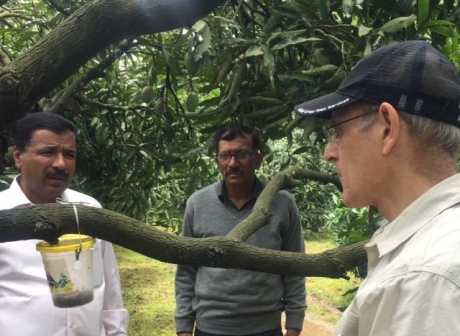
John Mumford with a Rainbow fruit fly trap. Rainbow aims to sell 1 million traps a year.

Professor John Mumford reflects on the remarkable success of a pest-control project that's adding value to rural life, in more ways than one.
India is the world’s biggest producer of mangoes, with around 2.5 million hectares under cultivation.
Most are grown by smallholders who rely on this crop for most of their income. There’s a healthy demand, but while good quality fruit can be sold at the farm gate for around $1.20 a kilo, damaged fruit is only good for pulp and juice, and it fetches just 20 cents a kilo.
The biggest culprit in damaging those mangoes – and their profit margin - is the ever-present fruit fly.
‘A dollar a kilo is a very big difference’
“These fruit flies lay their eggs on the surface of the fruit”, explains Professor John Mumford, Professor of Natural Resource Management; “then the maggots develop inside and once infested, they can only be sold to the processing market.”
The challenge then, is to protect the fruit while it’s growing on the trees, so that farmers can get the maximum price.
Some smallholders had tried spraying their crops, but that’s expensive and dangerous. Others had tried covering their mangoes with plastic bags, but with minimal success. As Professor Mumford explains: “What we wanted was a proven approach, adapted to meet local need.”
‘A huge collaborative effort’

Image above: John Mumford talking to two mango growers who have formed a local association to promote fruit fly control in their local area, with one of the fruit fly traps (and a lot of dead flies) hanging on the tree.
“By maximising the value of their mangoes, farmers can buy essentials and send their kids to school. And it makes mango production attractive enough for the next generation, so they don’t have to move to the city and work in a factory.”
– Prof John Mumford
In collaboration with the Indian Institute of Horticultural Research and other partners across India, the team developed a simple but highly effective ‘lure and bait’ trap which kills the fruit fly with insecticide.
‘It’s very low tech’ says Professor Mumford; ‘but well conceived and well delivered.’ And the effect has been remarkable.
“Farmers are around $6-7,000 dollars per hectare better off and there are tens of thousands - and potentially hundreds of thousands doing it.”
In fact, this solution is estimated to be worth around $500 million a year to the Indian economy. And that money is staying in rural areas where it’s needed most.
The impact on farmers and their communities cannot be underestimated says Professor Mumford: “By maximising the value of their mangoes, farmers can buy essentials and send their kids to school. And it makes mango production attractive enough for the next generation, so they don’t have to move to the city and work in a factory.”
‘It was lovely to see how things had taken off’
“It’s a great example of how a small initial investment that showed a lot of promise, was followed up and moved to a bigger area.”
– Prof John Mumford
The success of this project has been particularly gratifying for Professor Mumford, given its long gestation: “It’s a great example of how a small initial investment that showed a lot of promise, was followed up and moved to a bigger area.”
In fact, its roots date back to 1998, when the Professor was awarded a small grant from the UK Department for International Development (DfID) to look at a similar problem in Pakistan. In 2000, that project won a prize - and the Professor used the money to extend the work from Pakistan into the much larger fruit growing belt in Southern India.
Seeing the impact, the Indian Government stepped in with further funding in 2005 to extend the project. They put materials into local languages, worked with the local suppliers – and it flourished. Now there are plans to move into Northern and Central India, so the potential remains huge.
‘Bring us your interesting problems’
Professor Mumford joined the staff in 1979, so he’ll be familiar to many Imperial alumni – and now he’d like to invite those alumni to “bring us interesting work”. He encourages alumni to get in touch with cases where there is a pest or disease problem that remains unsolved.
He would also be happy to hear from any alumni in large food production and importing companies who are interested in developing “a supply chain that rewards small producers”; another of his enduring passions.
As a first step, please contact Patrick Stewart, Head of Development for the Faculty of Natural Sciences, on +44 (0) 20 7594 2667 or by email to patrick.stewart@imperial.ac.uk.
Article text (excluding photos or graphics) available under an Attribution-NonCommercial-ShareAlike Creative Commons license.
Photos and graphics subject to third party copyright used with permission or © Imperial College London.
Reporter
Jenn Rowater
Advancement

Contact details
Tel: +44 (0)20 7594 6697
Email: j.rowater@imperial.ac.uk
Show all stories by this author



